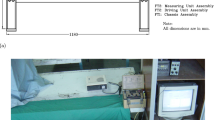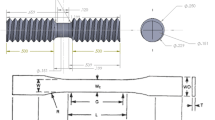Abstract
Many models use the equilibrium stress, also sometimes known as the back stress, in characterizing the response of both polymeric and non-polymeric materials. We study the characteristics of the equilibrium and show that the tangent modulus and local Poisson’s ratio at equilibrium both are rate independent for common modeling assumptions. This fact is used to propose a method based on uniaxial tension or compression to measure the equilibrium stress, and the associated point’s tangent modulus and local Poisson’s ratio. The method is based on cyclic loading and identification of similar states with vastly different loading rates. The method is used to characterize the equilibrium stress in glassy polycarbonate, and the results are studied in regard to the possible error for such a measurement. The method is faster than most other proposed methods for calculating the equilibrium stress, and provides additional measurements of parameters at equilibrium that are normally not obtained.









Similar content being viewed by others
Notes
There can be a difference between the equilibrium stress and the term in a model called the back stress. In particular this occurs when the plastic flow is selected to be materially constrained, such as is the case for the standard assumption of incompressible plastic flow. The difference is similar to the indeterminacy introduced by material constraints on the stress and can easily be evaluated. To avoid the potential confusion between the two, in the following we focus on the stress at equilibrium and denote it as the equilibrium stress or back stress.
References
Argon AS (1975) Plastic deformation in glassy polymers. In: Polymer materials: relationship between structure and mechanical behavior. American Society for Materials, Materials Park, pp 411–486
Argon AS, Bessonov MI (1977) Plastic flow in glassy polymers. Polym Eng Sci 17(3)
Argon AS, Bessonov MI (1977) Plastic deformation in polyimides, with new implications on the theory of plastic deformation of glassy polymers. Philos Mag 35:917–933
Boyce MC, Parks DM, Argon AS (1988) Large inelastic deformation of glassy polymers. Part I: rate dependent constitutive model. Mech Mater 7:15–33
Boyce MC, Parks DM, Argon AS (1989) Plastic flow in oriented glassy polymers. Int J Plast 5:593–615
Boyce MC, Arruda EM (1990) An experimental and analytical investigation of the large strain compressive and tensile response of glassy polymers. Polym Eng Sci 30:1288–1298
Arruda EM, Boyce MC (1993) Evolution of plastic anisotropy in amorphous polymers during finite stretch. Int J Plast 9:697–721
Arruda EM, Boyce MC (1993) Strain rate and temperature dependence in amorphous polymers at finite strain. In: ASME MD volume: use of plastics and plastic composites: materials and mechanical issues 46, pp 697–721
Arruda EM, Boyce MC, Quintus-Bosz H (1993) Effects of initial anisotropy on the finite strain deformation behavior of glassy polymers. Int J Plast 9:783–811
Boyce MC, Arruda EM, Jayachandran R (1994) The large strain compression, tension, and simple shear of polycarbonate. Polym Eng Sci 34:716–725
Boyce MC, Arruda EM, Jayachandran R (1995) Effects of strain rate, temperature and thermomechanical coupling on the finite strain deformation of glassy polymers. Mech Mater 19:193–212
Hasan OA, Boyce MC, Li XS, Berko S (1995) Constitutive model for the nonlinear viscoelastic viscoplastic behavior of glassy polymers. Polym Eng Sci 35:331–344
Arruda EM, Boyce MC, Jayachandran R (1995) Effects of strain rate, temperature and thermo-mechanical coupling on the finite strain deformation of glassy polymers. Mech Mater 19:193
Krempl E, Ho K (1995) Overstress model for solid polymer deformation behavior applied to Nylon 66. Polym Eng Sci 35:310–316
Krempl E, Bordonaro CM (2000) State variable model for high strength polymers. ASTM Spec Tech Publ 118–137
Krempl E, Khan F (2003) Rate (time)-dependent deformation behavior: an overview of some properties of metals and solid polymers. Int J Plast 19:1069–1095
Krempl E, Khan F (2004) Pre-necking and post-necking relaxation and creep behavior of polycarbonate: a phenomenological study. Polym Eng Sci 44:1783–1791
Negahban M (1995) Preliminary results on an effort to characterize thermo-mechanical response of amorphous polymers in the glass-transition range. In: ASME MD/AMD volume: mechanics of plastics and plastic composites, MD-vol 68/AMD-vol 215, pp 133–152
Negahban M, Goel A, Delabarre P, Feng R, Dimick A (2006) Experimentally evaluating the equilibrium stress in shear of glassy polycarbonate. ASME J Eng Mater Technol 128:537–542
Negahban M, Strabala K, Delabarre P, Goel A, Feng R, Grenet J (2007) Temperature dependence of the back-stress in shear for glassy polycarbonate. Macromol Symp 258:142–151
Neu RW, Scott DT, Woodmansee MW (2000) Measurement and modeling of back stress at intermediate to high homologous temperatures. Int J Plast 16:283–301
Ahlquist CN, Nix WD (1969) A technique for measuring mean internal stress during high temperature creep. Scr Metall 3:679
Onat ET (1976) Representation of inelastic behavior. In: Yale University Subcontract Report to Oak Ridge National Laboratory, ORNL/Sub/, p 3863–2
Sehitoglu H (1989) Changes in state variables at elevated temperatures. J Eng Mater Technol 111:192
Ward IM (1983) Mechanical properties of solid polymers, 2nd edn. Wiley, Chichester, pp 293–294
Hennig VJ (1964) Anisotropie des dynamischen Elastizitatsmoduls in einachsig verstreckten amorphen Hochpolymeren. Kolloid-Z 200:46–47
Rawson FF, Rider JG (1974) The elastic constants of oriented polyvinyl chloride. J Phys D 7:41–49
Wright H, Faraday CSN, White EFT, Treloar LGR (1971) The elastic constants of oriented glassy polymers. J Phys D 4:2002–2014
Kashiwagi M, Folkes MJ, Ward IM (1971) The measurement of molecular orientation in drawn poly (methyl methacrylate) by broad line nuclear magnetic resonance. Polymer 12:697–710
Kausch HH (1967) Elastic properties of anisotropic heterogeneous materials. J Appl Phys 38:4213
Kausch HH (1978) Polymer fracture. Springer, Berlin, p 33
Robertson RE, Buenker RJ (1964) Some elastic moduli of bisphenol A polycarbonate. J Polym Sci A2 2:4889–4901
Negahban M, Goel A, Zhang L (2008) Evaluating the development of elastic anisotropy with plastic flow. Acta Mech. doi:10.1007/s00707-009-0139-6
Negahban M, Wineman AS (1992) The evolution of anisotropies in the elastic response of an elastic-plastic material. Int J Plast 8:519–542
Negahban M (1995) A study of thermodynamic restrictions, constraint conditions, and material symmetry in fully strain-space theories of plasticity. Int J Plast 11:679–724
Negahban M, Wineman AS (1989) Material symmetry and the evolution of anisotropies in a simple material: I. Change of reference configuration. Int J Non-linear Mech 24:521–536
Negahban M, Wineman AS (1989) Material symmetry and the evolution of anisotropies in a simple material: II. The evolution of symmetry. Int J Non-linear Mech 24:537–549
Acknowledgment
The research reported in this article was partially supported by the U.S. Army Research Laboratory (ARL) under the RMAC-RTP Cooperative Agreement No. W911NF-04-2-0011.
Author information
Authors and Affiliations
Corresponding author
Rights and permissions
About this article
Cite this article
Goel, A., Strabala, K., Negahban, M. et al. Experimentally Evaluating Equilibrium Stress in Uniaxial Tests. Exp Mech 50, 709–716 (2010). https://doi.org/10.1007/s11340-009-9268-z
Received:
Accepted:
Published:
Issue Date:
DOI: https://doi.org/10.1007/s11340-009-9268-z




